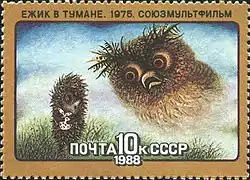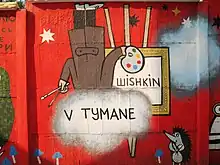Hedgehog in the Fog
Hedgehog in the Fog (Russian: Ёжик в тумане, tr. Yozhik v tumane, IPA: [ˈjɵʐɨk f tʊˈmanʲɪ]) is a 1975 Soviet animated film directed by Yuri Norstein[1] and produced by the Soyuzmultfilm studio in Moscow.[2][3] The Russian script was written by Sergei Kozlov, who also published a book under the same name. In 2006, Norstein published a book titled Hedgehog in the Fog, listing himself as an author alongside Kozlov.[4]
| Hedgehog in the Fog | |
|---|---|
 | |
| Directed by | Yuri Norstein |
| Produced by | Soyuzmultfilm |
| Written by | Sergei Kozlov |
| Starring | Aleksey Batalov Maria Vinogradova Vyacheslav Nevinny |
| Music by | Mikhail Meyerovich |
| Cinematography | Nadezhda Treschyova |
| Edited by | Natalia Abramova |
Release date | October 23, 1975 |
Running time | 10 min 29 s |
| Country | Soviet Union |
| Language | Russian |
Plot
Hedgehog (voiced by Maria Vinogradova) sets off for his evening visit to his friend Bear Cub. Every evening the two meet to have tea and count the stars. On this day, Hedgehog is bringing Bear Cub some raspberry jam as a special treat. As Hedgehog heads out, a sinister-looking eagle-owl stalks him.
As he walks through the woods, Hedgehog sees a beautiful white horse. As Hedgehog watches, the horse disappears into the heavy fog. Curious as to whether the horse will drown in the fog, Hedgehog decides to explore the fog for himself. As he travels into a valley, the fog is soon so thick that Hedgehog loses his way.
Believing he has spotted the white horse, Hedgehog instead discovers a leaf floating down with a snail riding on it. Hedgehog tries to touch the snail, but it mysteriously floats away and disappears. Another shadowy creature (which resembles an elephant) is so large and frightening that Hedgehog runs away, only to be startled by a black bat. All the while, the white horse is seen in glimpses. Finally Hedgehog spots the largest shape of all. Setting down his jam, he picks up a stick and pokes the large object to find it is a hollow tree. Suddenly he realizes he has lost his jam and searches frantically for it, only to find himself surrounded by the owl, the bat, and the shadowy elephant. He becomes more and more confused and frightened until a friendly dog emerges from the fog and returns the jam to Hedgehog.
Hedgehog attempts to find a way out of the fog, but falls into a river. He is resigned to let the river take him where it will when a mysterious voice asks what is wrong. The voice's owner (implied to be a fish) takes Hedgehog to shore, where Hedgehog finds himself back in the woods, free of the fog.
Resuming his journey, Hedgehog runs into Bear Cub (voiced by Vyacheslav Nevinny), who has been searching for his friend. At first Bear Cub scolds Hedgehog for being so late that the tea is cold and the fire has burned down, but eventually Bear Cub admits that he was worried that something had become of Hedgehog and that there would be no one with whom to watch the stars. The two sit by the fire and drink their tea. Bear Cub talks on and on about how glad he is to have found his friend, but Hedgehog stares in silence at the stars, wondering what became of the white horse.[5][6]
Creators

| Role | Name |
|---|---|
| Director and Animator | Yuri Norstein (Юрий Норштейн) |
| Writer | Sergei Kozlov (Сергей Козлов) |
| Art Director | Francheska Yarbusova (Франческа Ярбусова) |
| Animator | Yuri Norstein (Юрий Норштейн) |
| Camera Operator | Alexandr Zhukovskiy (Александр Жуковский) |
| Composer | Mikhail Meyerovich (Михаил Меерович) |
| Sound Operator | Boris Filchikov (Борис Фильчиков) |
| Script Editor | Natalya Abramova (Наталья Абрамова) |
| Voice Actors | Aleksey Batalov (Алексей Баталов) Narrator Maria Vinogradova (Мария Виноградова) Hedgehog Vyacheslav Nevinny (Вячеслав Невинный) Bear cub |
| Film Editor | Nadezhda Treshchyova (Надежда Трещёва) |
Awards
- 1976—Frunze All-Union Film Festival: Hedgehog in the Fog "best animated film"
- 1976—Tehran Children's and Youth Film Festival: Hedgehog in the Fog "best animated film"
- 2003—Tokyo All time animation best 150 in Japan and Worldwide: Hedgehog in the Fog "№1 Animated film of all the time"
Production
The fog effects were created by putting a very thin piece of paper on top of the scene and slowly lifting it up toward the camera frame-by-frame until everything behind it became blurry and white.[7]
Role in Soviet animation
Soviet-era children's animation and literature was faced with the task of producing politically acceptable content. Anthropologist Serguei Oushakine recognizes this atmosphere of indefinite deferment in the animation, stating: "The main thing is the work of imagination, or more precisely, the terror and pleasure with which it is linked. The final scene of pleasure, to which these various phantasmal and/or realistic experiences should indeed have led, is not included in the plot."[8] This is evident through the hedgehog's anxiety and fixation on the horse, even after he succeeds in meeting the bear for tea.
Legacy

Hedgehog in the Fog was ranked No. 1 in a poll at the 2003 Laputa Animation Festival where 140 animators from around the world voted for the best animated films of all time.[9]
Hayao Miyazaki, acclaimed animator of Studio Ghibli stated he drew his inspiration from many animators including Yuri Norstein.[10][11]
Since January 2009 the main character (the Hedgehog) from the movie has a statue in the city center of the capital of Ukraine, Kyiv.[12]
The film was spoofed in the third episode of the eighth season of the animated comedy series Family Guy, "Spies Reminiscent of Us", in 2009. [13]
The opening ceremonies for the 2014 Winter Olympics referenced this work, mentioning it in a list of signature Russian accomplishments and artists, including Fyodor Dostoevsky, Leo Tolstoy, and Sputnik.[14]
See also
- History of Russian animation
- List of stop-motion films
- List of films considered the best
- Night on the Galactic Railroad
References
- Jeff Lenburg (2006). Who's who in Animated Cartoons: An International Guide to Film & Television's Award-winning and Legendary Animators. Hal Leonard Corporation. pp. 264. ISBN 978-1-557-83671-7.
- "The 77 best kids' films of all time. Hedgehog in the Fog (1975)". telegraph.co.uk. 6 May 2017. Retrieved 25 May 2017.
- Clare Kitson (2005). Yuri Norstein and Tale of Tales: An Animator's Journey. Indiana University Press. pp. 46–48. ISBN 978-0-253-21838-4.
- Ежик в тумане. Ozon.ru. Retrieved on 2012-11-23.
- Maureen Thomas,François Penz (2003). Architectures of Illusion: From Motion Pictures to Navigable Interactive Environments. Intellect Books. ISBN 978-1-841-50045-4.
- Mark Whitehead (2004). Animation: The Pocket Essential Guide. Summersdale Publishers LTD - ROW. p. 113. ISBN 978-1-848-39836-8.
- "Все свободны" – разговор на свободные темы. svoboda.org (2007-07-04)
- Alaniz, José (2011). "Reviewed work: Veselye chelovechki: Kul'turnie geroi sovetskogo detstva. Nauchnaia biblioteka, I. Kukulin, M. Lipovetskii, M. Maiofis". Russian Review. 70 (3): 513–515. JSTOR 41289990.
- 世界と日本のアニメーションベスト150. ふゅーじょんぷろだくと. 2003. ASIN 4893933671.
- ""Снежная королева": почему без этого советского мультфильма у японцев не было бы аниме". russian7.ru (in Russian). Retrieved 2020-08-17.
- "Bloomsbury Collections - Princess Mononoke - Understanding Studio Ghibli's Monster Princess". www.bloomsburycollections.com. Retrieved 2020-08-17.
- "Monument to 'Hedgehog in Fog' appeared in Kyiv", UNIAN (2009-01-27)
- "Family Guy" Spies Reminiscent of Us (TV Episode 2009)-Connections-IMDB
- NBC sets talky tone with Olympics Opening Ceremony|Tube Talk|stltoday.com
External links
| Wikiquote has quotations related to: Hedgehog in the Fog |
- Hedgehog in the Fog at the Animator.ru
- Hedgehog in the Fog at IMDb
- Hedgehog in the Fog at AllMovie
- Hedgehog in the Fog at the Keyframe – the Animation Resource
- Hedgehog in the Fog on YouTube with English subtitles
- Laputa Animation Festival 2003 (in Japanese)
- BBC Article about Soviet brands, including "Ёжик в тумане" in Russian
- Norstein's Studio Official Website